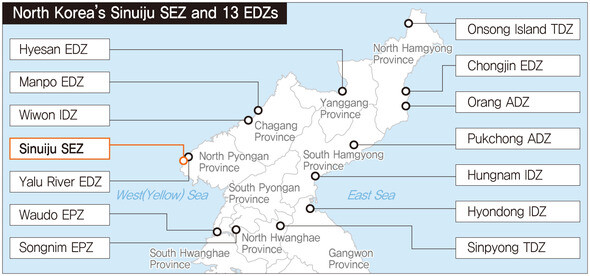hankyoreh
Links to other country sites 다른 나라 사이트 링크
North Korea to set up 14 new special economic development zones

By Kim Kyu-won, and Choi Hyun-june, staff reporters
North Korea has announced plans to set up one Special Economic Zone (SEZ) and 13 Economic Development Zones (EDZ), almost one in each province, with the objective of developing the economy and attracting foreign direct investment. If the 14 zones are successful, they could eventually lead North Korea to reduce the barriers in its economy and create more growth.
North Korea’s official Korean Central News Agency (KCNA) reported on a political decree from the Presidium of the Supreme People’s Assembly that stated, “The DPRK decided to set up a special economic zone in some parts of Sinuiju, North Pyongan Province”. The KCNA report confirms murmurs about North Korea’s SEZ and EDZ.
According to the decree from the Presidium, “The sovereignty of the DPRK will be exercised in the zone,” implying the Sinuiju SEZ will be open to foreign investors. It is expected that Sinuiju will play a key role in opening up and developing the North Korean economy, as the city is located along the border with China and is close to other SEZ that North Korea is working on developing with China: Hwanggumpyong and Wihwa islands.
“It is meaningful to hear the announcement of the decree from the North’s Supreme People’s Assembly because it confirms and elaborates on what had previously been only roughly discussed. It specifies 13 regions and their objectives for the development”, said Kim Eui-do, spokesperson from South Korea’s Ministry of Unification. “The plan is to attract foreign capital to push the developments, but it will be different from Rason-Sonbong or Kaesong since the newly announced zones will not seek to open up their economy more generally, but to pursue foreign investment in a limited way.”
The announced 13 EDZs include; Yalu River Economic Development Zone at Sinuiju City’s Ryongwun Village, Sinpyong Tourism Development Zone and Songnim Export Processing Zone in Hwanghae Province, Manpo Economic Development Zone and Wiwon Industrial Development Zone in Chagang Province, Hyondong Industrial Development Zone in Gangwon Province, Hungnam Industrial Development Zone in South Hamgyong Province and Pukchong Agricultural Development Zone in Pukchong County in South Hamgyong Province, Chongjin Development Zone and Orang Agricultural Development Zone and Onsong Island Tourism Development Zone in North Hamgyong Province, Hyesan Economic Development Zone in Ryanggang Province, and Waudo Export Processing Zone in Nampo City.
The next question is how the announcement of the 13 EDZs will stimulate and speed up North Korea’s efforts to develop its economy and attract foreign direct investment. It is believed that North Korea has designated around 1.5-8 km2 for each zone, amounting to 44.3 km2 in total. Its plan includes developing each zone according to the specific characteristics of the region such as the economy, tourism, export processing, industry or agriculture. North Korea‘s target for foreign investment in each zone ranges from US$70 million to US$240 million, for a total of US$1.59 billion.
“It is likely that the announced development plan will become a symbol for Kim Jong-un’s economic drive”, said Kim Yong-hyun, professor at Dongguk University. “The North‘s plan could have gained better momentum if the announcement was made at a time when there was some progress in dealing with the nuclear issue. Otherwise, I doubt there will be any drastic changes.” Professor Kim continued, “Particularly, Chinese investors would be most interested in the news, but I suspect such interests would be only limited to Sinuiju, Hamgyong Province, or Nampo - where they all border China”.
Followed by Kim Jong-un’s order in March to set up an EDZ in each province during a plenary meeting of the Central Committee for Workers’ Party of Korea, Pyongyang has taken subsequent actions including organizing a National Committee for Economic Development.
Translated by Lee Dong-ju, Hankyoreh English Intern
Please direct questions or comments to [english@hani.co.kr]

Editorial・opinion
![[Correspondent’s column] China-Europe relations tested once more by EV war [Correspondent’s column] China-Europe relations tested once more by EV war](https://flexible.img.hani.co.kr/flexible/normal/500/300/imgdb/original/2024/0628/7617195640940814.jpg) [Correspondent’s column] China-Europe relations tested once more by EV war
[Correspondent’s column] China-Europe relations tested once more by EV war![[Correspondent’s column] Who really created the new ‘axis of evil’? [Correspondent’s column] Who really created the new ‘axis of evil’?](https://flexible.img.hani.co.kr/flexible/normal/500/300/imgdb/original/2024/0628/4017195633070654.jpg) [Correspondent’s column] Who really created the new ‘axis of evil’?
[Correspondent’s column] Who really created the new ‘axis of evil’?- [Editorial] Exploiting foreign domestic workers won’t solve Korea’s birth rate problem
- [Column] Kim and Putin’s new world order
- [Editorial] Workplace hazards can be prevented — why weren’t they this time?
- [Editorial] Seoul failed to use diplomacy with Moscow — now it’s resorting to threats
- [Column] Balloons, drones, wiretapping… Yongsan’s got it all!
- [Editorial] It’s time for us all to rethink our approach to North Korea
- [Column] Why empty gestures matter more than ever
- [Editorial] Seoul’s part in N. Korea, Russia upgrading ties to a ‘strategic partnership’
Most viewed articles
- 1Yoon echoed conspiracy theories about Itaewon disaster, former National Assembly speaker says
- 2After 7 years, South Korea resumes live-fire drills on islands a stone’s throw from North
- 3Dreams of a better life brought them to Korea — then a tragic fire tore them apart
- 4[Correspondent’s column] Who really created the new ‘axis of evil’?
- 5S. Korea joins US, Japan for first multi-domain drills at a time of escalating tensions
- 6Yoon-picked brass of anti-corruption agency pushed to end probe over first lady’s Dior bag scandal
- 722 years later, Korean girls killed by US troops remain a symbol of the price of military tensions
- 8Korea declares ‘national emergency’ over birth rates, but offers few new solutions
- 9Seoul hints at lethal weapons aid to Ukraine to put pressure on Russia
- 10US nuclear-powered carrier arrives in Busan for drills with South Korea, Japan